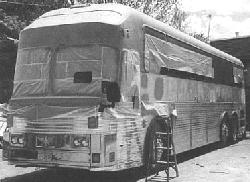

Masking is a talent which simply takes patience, and the right materials. I hate to blow anyone's horn, but I personally, will only use masking tape made by Minnesota, Mining and Manufacturing (3M). There are other makers of masking tape which may be just as good, but this is a fetish with me. 3M masking tape has the capacity of lasting for several days, even in the sun, and still releasing from the surface without printing or vulcanizing. Cheaper tapes react to the ultraviolet spectrum of the sun becoming brittle, and bake onto the surface, requiring solvent cleanup. This will, unfortunately, remove the paint you just applied.
Masking paper may be purchased from any automotive paint supply company. A simple, inexpensive masking machine may be purchased from many tool outlet shops. It is nothing more than a stand with a mandrel for the paper and one for the tape which allows both to be removed simultaneously with half of the edge of the tape sticking to the edge of the paper. Then a serrated cutter allows one to tear off a strip of paper with the tape pre-stuck to one edge. The days of the newspaper for masking are over. Before using the masking paper, carefully go around each element with masking tape, making sure the edges are fully covered. Then the paper is used to finish covering the element.
For finished sharp and clean edges use fine line tape. This is a tape similar to electrician's vinyl tape, but much thinner. When applied, this fine line tape will leave a clean sharp line, whereas the standard crepe paper masking tape will leave a ragged edge where the paint has bled through under the tape.

Carefully mask all of the areas of the coach not be painted, such as around windows and windshields. Any items which can be removed such as lamps or mirrors, should be. Also, remove any trim strips or molding, unless they are to be painted. If you have bright metal siding to be protected from paint, it should be wrapped with polyethylene film, especially if it is along the lower section of the coach, such as on an Eagle. This plastic is readily available from a garden supply shop or a home improvement store. If the bus must be moved after it has been masked, simply cut a little window out of the paper in front of the windshield as shown in the photograph.
The primer paint may be shot with a cheap gun, which may be bought at a discount warehouse or discount tool outlet. The reason we can get by with inexpensive tools is that it is a one time operation for the reader. These cheap tools are copies of more expensive domestic built tools and some of them are really quite good.
The primer material is normally an acrylic lacquer base. Other primer materials may be an epoxy base or a urethane base. This is a subject where you should consult with a professional. Or you might consult with your automotive paint supplier. Sherwin-Williams probably has the most knowledgeable sales personnel, since S-W manufactures most of the industrial coating systems in the country. Other respected manufacturers are Pittsburgh Plate Glass and DuPont. The paint made by Sikkens, a Dutch company, has probably the biggest selection of colors available from any manufacturer.
The color of your primer should probably be a light grey. This primer color can successfully be covered and hidden by almost any finish color. The final prime coat should be a sanding primer. Sanding primer will fill pin holes, and may be finish sanded to an exceptionally smooth surface. It is suggested the final finish sanding be done by hand with number 440 grit, and then use the flat of the hand to test for any imperfections.
